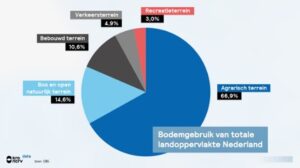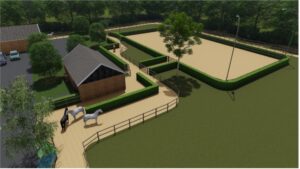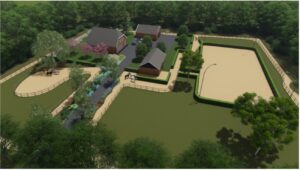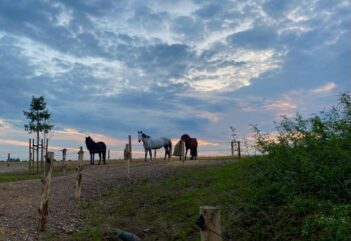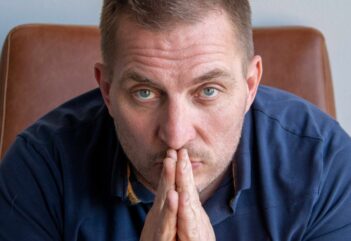- Wednesday April 19 2023
- Blog
Is the 'natural keeping' of horses in the Netherlands feasible?
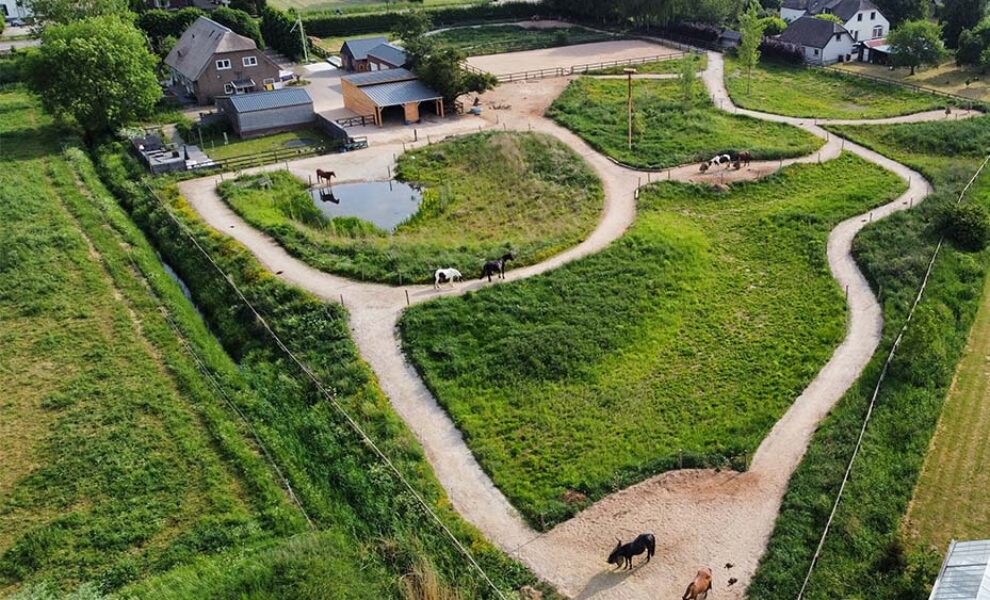
As a horse owner or equestrian entrepreneur, you may be considering switching to a Paddock Paradise system. You have read up, asked around and you may have visited stables where the concept is already running. You are enthusiastic, but you do not yet know exactly how and as an entrepreneur you doubt whether this transition is the right one.
You support the concept whereby horses are given more freedom of movement, can show more natural behaviour, we all want our animals to have a good life and so we regularly ask ourselves how we can take better care of our horses and how we can prevent illness and lameness. In other words, how do we keep our horses healthy and happy!
To find an answer to this simple question, it is important to first determine under which circumstances a horse functions best. But what do you look at and what is best for your horse?
Now everyone here will of course have his or her own opinion on this, but I think that if we really want to take the horse seriously, we would do well to look at the nature of this species. In my previous blog PADDOCK PARADISE NETHERLANDS I have tried to make this as clear as possible.
The nature horse
The available information on horses in their natural habitat clearly suggests that these animals function particularly well under specific conditions.
I believe the only correct way to do this is to look at horses that are still living in a natural way. How these animals behave with each other, what they do during the day and why they become lame or sick.
In this way we can make a meaningful translation to the kept horse. Because, domesticated or not, a horse is a horse.
As you may know, there are approximately 70 million horses worldwide.
Approximately 1.5 to 2 million of these animals live in the wild and less than 10% of wild horses live in a natural habitat for the species. Only a small part of this percentage is currently not or hardly under the influence of humans.
With so many animals in 'captivity' and only a small part in an exemplary environment, it is quite difficult for a horse owner to get a feeling for the horse in a natural environment. Let's determine what horse welfare really means!
In this way we can make a meaningful translation to the kept horse. Because, domesticated or not, a horse is a horse.
But before we can make such a translation, we must be able to reach agreement on what is and what is not natural for these animals. Strangely enough, despite all the information we have at our disposal, there is still quite a lot of uncertainty about this.
Our connection with the horse has become so strong over a period of 6.000 years that we have lost sight of their origins. Gradually our society has changed and the horse had no choice but to go along with it. Our intercontinental travel urges have also led to horses being found on almost all continents today. Both in captive situations and in the wild. And that's where part of the problem starts, because the horse can survive in the craziest places and so 'wild' becomes a broad concept.
Being able to survive somewhere does not necessarily mean that you belong there, nor is it a guarantee of health. The principles of the Paddock Paradise® system are therefore based on the way of life of animals that live in their natural habitat.
How do we do this in the Netherlands?
Simulating a natural lifestyle is not that complicated, but it does require the necessary adjustments.
Imitating a natural way of life is not that difficult, but it does require the necessary adaptation of people and their environment.
Here too it is therefore good to first make a calculation:
According to statistics, we have about 1.8 million hectares of agricultural land in the Netherlands. Of this, 1 million hectares consists of grassland. Dutch livestock farming provides space for approximately 3.8 million cattle.
Image source: CBS
If, for the sake of convenience, we only count dairy farming (approx. 1.7 million cows) and want to provide it with the prescribed 2 hectares per cow all year round, then it should be clear that cattle soon lose out when it comes to freedom of movement. Undoubtedly there are farms that reach the prescribed 2 hectares, but the animals will not be able to use that every day of the year.
When it comes to grazing for cows, we should therefore not think of continuous grazing of all plots. This would be at the expense of the yield of silage and hay and thus ultimately of milk production. Grazing also limits the possibility of spreading manure. The cattle in our country quickly produce 60 million tons of manure, so we need some space for that – for as long as it lasts.
In this report https://edepot.wur.nl/274863 from WUR, the complexity of grazing and the importance for the industry of spreading freedom of movement are clearly highlighted.
The consequences
Apart from the discussion about this policy and the consequences for cattle, it should be clear that these figures also have far-reaching consequences for the horses in our country. With an estimated number of 450.000 animals in combination with the amount of land available, it is simply not feasible to put all horses outside and on pasture 24/7. And even if this were successful, the vast majority of the animals would suffer from health problems during the spring and summer months. Health problems arising from consuming large amounts of grass or silage.
The solution for the horses seems obvious. To encourage more exercise, more natural behavior and therefore greater welfare in horses, the sector should switch to the Paddock Paradise® principle as quickly as possible. Depending on the number of horses to be kept and the amount of land available, on average about a quarter of a plot will be sacrificed to a Paddock Paradise. This remaining land can be used permanently for the development of hay fields, new nature, water extraction areas or other suitable use for the relevant destination.
The most important advantages of the Paddock Paradise® system at a glance:
- continuous freedom of movement
- permanent possibility for socialization (herd connection)
- dry and walkable substrates throughout the season
- different protection options
- reduction and elimination of lameness and disease
- more room for nature development and nitrogen fixers
- improving water management
- biological management of grass and flower meadows
- fewer accidents for riders (horses are less stressed)
- reducing ammonia emissions
- room for development and innovation
Nature inclusiveness and Well-being are the two main characteristics of the Paddock Paradise® housing system.
Are there no disadvantages at all?
Yes, there are. In a Paddock Paradise®, horses depend on good quality roughage. And this roughage not only has to be harvested somewhere, it also has to be stored carefully. On the other hand, this housing system permanently provides more 'green space' and the barns formerly intended for stables can serve as storage.
Many municipalities are less familiar with this housing system (witness this recent article by LTO Nederland: The future-proof horse industry – LTO ) and it is therefore important to properly introduce a permit application and to prepare yourself well. The Paddock Paradise principle is not reflected in regulations and officials sometimes struggle with the question of whether it is appropriate within the landscape. A good reason, therefore, to focus strongly on appropriate natural elements in a design, in order to give governments room to stimulate the construction of nature. This incentive makes it easier to include cultural landscape values in the design and to let the 'new nature' work to the advantage of the horses. Planting not only brings new life, it can also provide shelter for the animals.
Did you know that many municipalities and provinces reimburse up to 90% of a planting plan?
Work also changes. Depending on the type of soil on which the horses stand (sand, semi-paved), the vast majority of the path system will have to be mucked out manually. In any case, people must go outside to keep paths and rest areas free of manure, and the feeding stations will also have to be replenished daily.
There is a solution for every problem and there are countless possibilities to involve boarding clients in the care of their horse. For example, by using multiple revenue models. Those who pay more do less, those who pay less do more. Associations even draw up real work schedules in which the often paid activities for members are described.
Switch from
It requires the necessary knowledge and motivation for a traditional horse farm to make the switch to this more natural form of horse keeping. Often a view has to be overhauled and in most cases the necessary investments will have to be made. But when we look at this professionally and in the longer term, it is not much different for a starting entrepreneur than investing in, for example, a stable complex, and for established equestrian entrepreneurs it is comparable to an investment or renovation of the existing company.
Yes, they may lose some existing customers. There will always be people who stick to what they know or have learned about keeping and caring for horses, even when what they have learned needs to be updated. A stable and a pasture remains an ideal for many people for the time being.
In conclusion
In view of the limited space, grazing is in practice not feasible for every horse and from a welfare point of view, stables in 2020 cannot be called very progressive. In addition, there are just as many or even more people whose perspective on well-being has already changed.
The fear of losing business is therefore unfounded. Experience shows that all good movement or 'loose stables', so to speak, have long waiting lists. And those waiting lists are there for a reason. Many horse owners recognize that exercise, proper nutrition and the opportunity to socialize are critical to the health of not only their horses, but also other animals within the livestock industry.
In these times of overpopulation, the burgeoning threats of infection from a pressurized factory industry and the great physical and mental pressure this puts on us and our animals, it seems only logical that we change.
Are you changing?
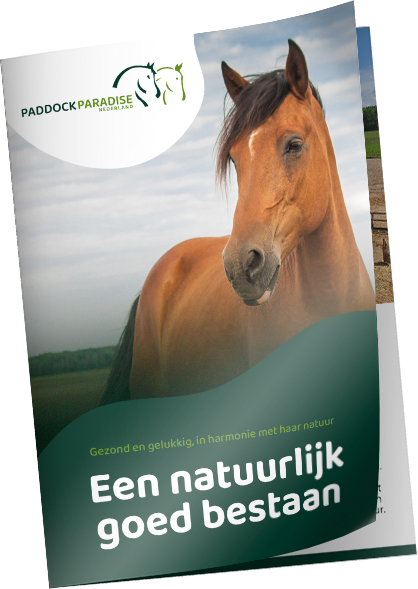
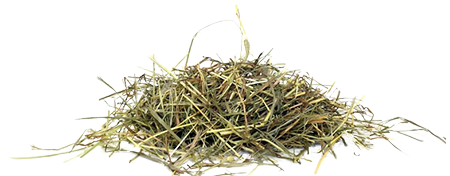
Do you wish for your horse to have a naturally sound life?
We personally supervise all our projects. We are committed and consistent in sharing our advise and tend to everything: from excavation work to fencing, from permits to design plans. And with immediate results. Attentive horses in motion. Healthy, happy, and in harmony with nature.
Would you like more information about the possibilities for realizing your Paddock Paradise? Download our E-book or contact us personally.



